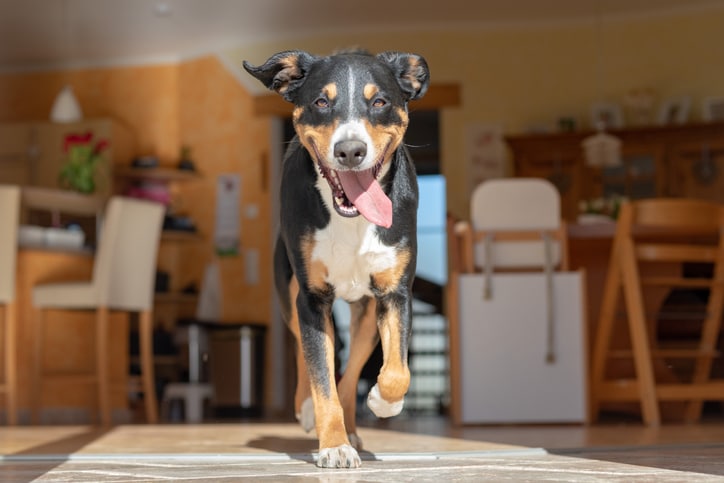What are the zoomies? The zoomies are a sudden burst of activity from your dog often manifesting as the tucking of their hindquarters as they race wildly, or zoom, around the house or garden. There may be many causes for the zoomies but, ultimately, this behaviour is considered normal in dogs.
Read on to find out why dogs get the zoomies and the most common times they occur, plus what pet owners should do when their pup gets a crazy case of the zoomies.
What causes the zoomies in dogs?
The most common reason for the zoomies is that a pet has pent-up energy that they need to release. The zoomies aren’t specific to certain dog breeds, but they may be more common in high-energy dogs, especially those that do not get regular exercise.
However, a lack of exercise is not the only cause of dog zoomies; the zoomies are also a way for dogs to release their emotions. Many dogs simply have the zoomies because they feel big emotions such as excitement. And just like expressing emotions is healthy for humans, it’s also perfectly healthy for dogs.
Do you have a dog that never gets the zoomies? That’s normal as well. Some dogs may have more outlets for their energy during the course of the day and are too tired for the zoomies. Others may be less likely to exhibit this behaviour due to their breed, age and personality.
The most common types of dog zoomies and why they happen
The official scientific term for dog zoomies is Frenetic Random Activity Periods or FRAPs. The key word here that dog owners should note? Random. It’s most common for the zoomies to start without warning. When your dog takes off running, they may jump on furniture, run in circles or take sharp turns, and some may bark.
But despite their unpredictable nature, the zoomies do serve a purpose, and some circumstances can tell you a lot when it comes to determining what’s causing your dog to zoom. These are a few of the most common types of dog zoomies and why they happen.
Puppy zoomies
The cause: An abundance of stamina
Puppies get the zoomies because they tend to have higher exercise requirements and more energy to burn than older dogs. In fact, the zoomies appear to be most common in younger animals in general, and puppies can start experiencing the zoomies at just a few weeks old. Many dogs continue to get the zoomies their entire lives but, as dogs age, the frequency and duration of the zoomies often decline.
Dog zoomies at night and in the morning
The cause: Hours of built-up energy
It is common for dogs to get the zoomies at night after spending a day home alone or in a crate, since they’ve had limited activity to release their energy. The same goes for early morning zoomies for dogs that sleep in a crate. At these times, dogs may feel the need to expel their built-up energy suddenly with a FRAP.
Dog zoomies after a bath or a training session
The cause: Having to be still for too long
Dogs often get the zoomies after a bath, as well as after — or even during — a training session. This can come from frustration from not being able to move around enough, leaving the dog suddenly feeling the need to let out a burst of energy.
Dog zoomies during playtime
The cause: Excitement or overstimulation
The zoomies during playtime are often due to pure excitement. This is even more likely to occur when your dog is in a new environment, like a new day care or dog park.
Are the zoomies a sign of a happy dog?
Signs of a happy dog are actually different from signs of the zoomies. Dogs may exhibit happiness when they see a favourite person or when there’s the expectation of something good coming, such as when you’re making their dinner. This can cause uncontrollable movement. They may run, jump, spin in a circle and so on, but this is not really the zoomies as much as it is their way to show excitement for something they know they enjoy. The zoomies most often come out of the blue when least expected and the dog needs to use up excess energy.
Having said that, it’s probably safe to say dogs are not unhappy when they get the zoomies. We can’t read their minds, but based on their body language, they appear to be having a good time when they have the zoomies.
What should you do when a dog gets the zoomies?
In general, it’s best to allow dogs to simply enjoy getting out their energy when the zoomies strike, unless they are in danger of hurting themselves or others. If the time of day is predictable, you can even consider taking your dogs outside to zoom. Otherwise, try to make sure they have an unobstructed area to zoom, then sit back and enjoy the fun.
Once the zoomies start, they may be hard to stop until your dog decides they’re tired. Some human behaviours can intensify a zoomie session, like chasing your dog or making excited noises. Once you have ensured your valuables and fragile items are out of the path of the wild zoomies, try leaving the room or staying quietly out of harm’s way. Your calm energy may help your dog’s excitement to subside more quickly.
How to control dog zoomies
Again, dog zoomies are normal and not a cause for concern. However, to keep your dog safe, try to discourage the zoomies from occurring around stairs or slippery floors like tile or hardwood to keep your dog safe indoors. Outside, make sure the space is enclosed and do your best to remove hazards like holes, water and sharp objects.
Think your dog is zooming a bit too much? Take note of the timing of your dog’s bursts of energy. If your dog always zooms after being home alone, after extended periods of rest, or in the middle of your sleep schedule, this may be your dog’s way of telling you they need more exercise or mental stimulation. In that case, try adding these activities to your dog’s day to avoid a build-up of explosive energy:
- Walking or jogging in a new location, depending on your dog’s age and health
- Playing with a puzzle toy that expelskibble or treats under certain conditions
- Learning a new trick — no dog is too old!
- Finding a hidden treat somewhere inside the house as a game
- Chasing a ball, laser toy or other dog toys
- Swimming

